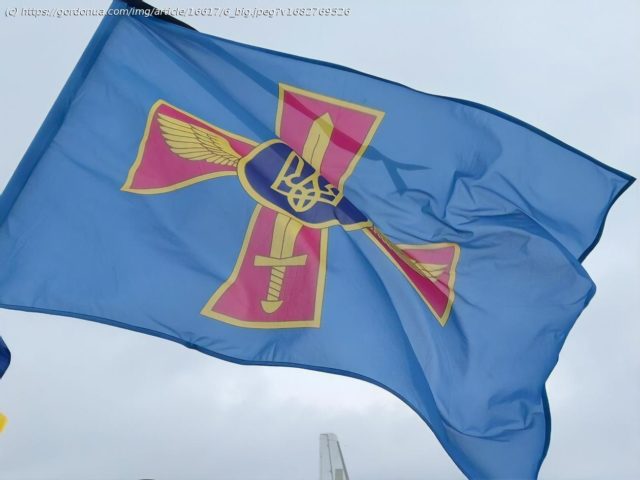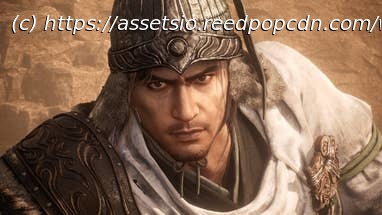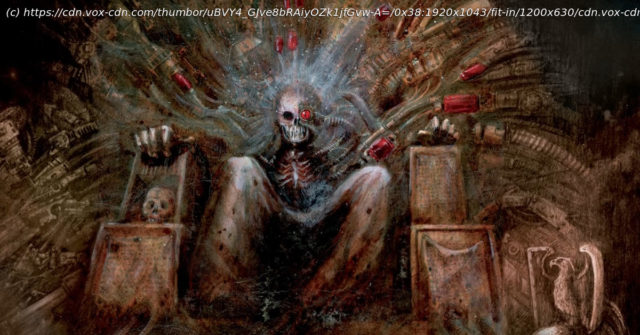Warhammer 40,000 has expanded far past the original wargame to become a massive franchise with decades of lore to parse through. Here’s what you need to know.
Warhammer 40,000 is a tabletop wargame played with miniatures that first launched in the 1980s, alongside rulebooks packed with additional fluff and lore. Decades later, that fluff has sprawled out into its own massive narrative universe, and the lore has been adapted into novels, audio dramas, movies, animation, and video games. Warhammer 40K, the media property, is currently in pre-production as a TV and cinematic universe led by Superman and The Witcher star Henry Cavill. Meanwhile, the wargame is about to enter its 10th edition, which aims to be more accessible and pared-down than previous versions.
You’ve likely seen images from the brand, or announcements about a new game or adaptation in the universe. If you’re curious about this huge franchise, you probably want to know: What is the world of Warhammer 40K about? Let’s dive in.What even is a Warhammer 40K?
There has been little active curation of Warhammer 40K canon. Instead, Games Workshop and its publishing arm Black Library has taken the stance that everything ever written about its sprawling lore is “true” — all of it is canon, more or less since its inception in the 1980s. Just like actual history, no single narrator or historian in the grim darkness of the far future is 100% reliable. Instead, it’s up to the reader to sift through all the dusty — and highly collectible — tomes in order to parse its primary sources.
Much like real history, it can be hard to piece everything together. Fan wikis and forums can be esoteric and packed with proper nouns. Meanwhile, since the narrative has never been rebooted or retconned, there are few official on-ramps for new players. But it’s possible to engage with the 40K fandom with a running start, gathering up bits of its nearly 40-year backstory as you go along. We’ve created this guide with newcomers in mind, and we’ll pepper our primer with recommendations for games, books, videos, and even entire factions that you might want to learn more about.Warhammer 40k’s setting
Warhammer 40K began as a pastiche of science fiction and fantasy tropes. For instance, looking back at its inception in the late ’80s, you’ll find elements from Frank Herbert’s Dune, with a God-Emperor, a hatred of AI, and the spacefaring Navigators. But, even early on, you’ll also find more literary call-backs, including nods to John Milton’s Paradise Lost.
Its earliest official work, Warhammer 40,000: Rogue Trader (written by Rick Priestly), begins with a preamble, a kind of Star Wars-style opening crawl that lays out the most basic facts that the reader needs to know. It’s been changed and altered over the years, but here are the original words from 1987:
Later rewrites of this piece add in references to the top-selling Space Marines and their comrades, but the bleakness of the God Emperor’s reign has never been in question.
Warhammer 40K was originally conceived as a political satire and as an anti-fascist work of fiction. Nevertheless, over the decades, the hobby has attracted no small number of right-wing fans who buy into either the in-universe propaganda of the Imperium, or the marketing materials that describe the Space Marines and friends as noble protectors of humanity. In recent years, Games Workshop has spoken out against this fan movement, itself calling back to the original preamble penned by Priestly.Meet the Imperium of Man
Before we delve into the finer details of the modern setting, it’s clear that humanity should not be thought of as the good guys in 40K. From the very beginning of the franchise to the current day, the Imperium is one of the most villainous factions in the entire galaxy, as cruel or perhaps more cruel to its own citizens than it is to outsiders it considers to be a threat to its way of life.
The Imperium remain the franchise’s nominal main characters. They give the larger fiction its point-of-view in most instances, and absorb much of the spotlight. This is even more extreme with the Space Marines, Games Workshop’s top sellers. Authors will often hype them up and praise their virtues, outright ignoring or otherwise skipping over uncomfortable topics like their tendency toward fascism and their origins as brainwashed child soldiers.
So, why are they so dang fun to read about? Take Frank Herbert’s Dune, gothic Christian imagery ramped up to 11, and giant war machines. Throw them all in a blender, and you get 40K’s Imperium of Man. Battle nuns drop cathedral tanks from orbit on their enemies. The Adeptus Mechanicus, a transhuman faction of religious cyborgs, chant religious rites to the machine spirits inside tanks. The Astra Militarum, also known as the Imperial Guard, is a faction made up of trillions of normal dudes in flak armor whose commissars urge them forward at gunpoint. It’s a wild take on dystopian, far-future sci-fi, far removed from any of our current problems. The Imperium fucking sucks to live in, but it’s fun to read about, and they have one redeeming quality — they aren’t the other guys.Recommended Media:
Space Marine is a solid and accessible action game that stars Captain Titus, an Ultramarine at war against the Orks invading Forge World Graia.
Darktide is the best chance you’ll have to explore a Hive City for yourself. The level design and soundtrack are immaculate and make Warhammer 40K feel very tangible.
The Vaults of Terra series by Chris Wraight is a procedural crime drama that takes place on Terra, at the foot of the Golden Throne itself.
The Inquisition novels by Dan Abnett make up a sprawling trilogy of trilogies, packed full of day-to-day life for the poor souls in the Imperium — and the Inquisitors who watch over them.
Fire Caste by Peter Fehervari is an Apocalypse Now homage, told through the tale of Imperial Guard soldiers pursuing warriors of the T’au Empire.From 15K to 40K
The Imperium is based on real-world history, but since it’s so far in the future, there are some big gaps in the timeline. We know that the Emperor of Mankind and his closest group of allies are Perpetuals, immortal humans that are reborn into new vessels after perishing. They’ve been in the background of all of history, pulling strings and setting up pieces on the chess board. Here are some of humanity’s historical eras that end up setting the scene for 40K.
Dark Age of Technology (~15,000-25,000 CE): Long after we were all gone, humanity hit its pinnacle and created a fully automated space utopia. Then, the AI-controlled Men of Iron rose up to kill humanity — and almost succeeded. This is why AI has been outlawed in 40K; the acronym now stands for abominable intelligence. In its place is a kind of horrific bio-engineering, which uses human minds and bodies as the material for new robot-like entities like servo-skulls and servitors. The Dark Age tech that survived usually crops up again and again in the modern timeline to cause some kind of problem, but we otherwise know very little about this era.
Age of Strife/The Long Night: With space travel shut off and the Men of Iron revolt leaving humanity in ruins, the survivors fell to civil war, Mad Max: Fury Road style, but across multiple star systems. The Emperor of Mankind showed up on the main stage, created a faulty race of transhuman soldiers known as the Thunder Warriors, and forcibly united humanity under his banner. Large parts of the race were stranded because their faster-than-light tech went down with the Dark Age of Technology, and they were left to face constant assault and enslavement from alien xenos.
The Great Crusade: The Emperor used his gang of genetic scientists to improve upon the Thunder Warriors, who were all dying horribly. The first step was to create 20 perfect sons based on the Emperor’s own DNA, but Chaos interfered by taking these Primarch and yeeting them to the far corners of the galaxy. The Imperium of Man began to scour the stars, searching for the Primarchs even as it began bringing all human worlds back into the fold – whether they wanted to join or not. During this time, two Primarchs were disappeared by the Imperium for unknown reasons, and permanently scrubbed from the historical record.
Horus Heresy: The Horus Heresy is the civil war that followed the Great Crusade. For those living in the current timeline of 40K, the Heresy — and even the Primarchs themselves — are the stuff of myth and legend, only known through the practices of Imperial cults and scraps of history passed down through the generations. Their story, set in the year 30K, has become so popular that it’s now its own standalone wargame accompanied by over 60 novels. This is a big Greek tragedy, where half of the Primarchs fall to Chaos and rebel against their tyrannical father. In the end, Horus is obliterated and the Emperor is badly wounded, leading to the slow decay of the Imperium and the institutionalization of a mandatory religion worshiping the God-Emperor. Ironic, considering the guy was a mega atheist, but he’s too busy sitting on the Golden Throne — an ancient bit of tech that just barely manages to keep him alive — to have any say about it.
Warhammer 40,000: This is the era that most fans of 40K, lapsed or otherwise, think of when they think of the franchise. But, for real-world decades, the “main plot” of the universe sat stagnant; there were no further progressions in the main setting, just new editions of the game that were pumped out on a roughly three-year cycle. Instead, the Black Library and publishing arms of Games Workshop fleshed out what life was like in the Imperium of Man with works like Dan Abnett’s Inquisition novels, or Sandy Mitchell’s Ciaphas Cain novels. Smaller-scale stories unfolded in this setting, but there were no major shake-ups until recent years.
Era Indomitus (42,000 CE): In the Gathering Storm campaign supplement books released in 2017, one loyalist Primarch — Ultramarine and administrator extraordinaire, Roboute Guilliman — returned. Unfortunately, around the same time, Chaos also split the galaxy in half, creating the Cicatrix Maledictum. Warhammer 40K and its extended materials have focused on the response to Guilliman’s return and the new nature of the post-split galaxy. A second loyalist Primarch, Lion el’Jonson, has recently returned as well, setting up a post-Heresy grudge match for the very future of the Imperium itself.The Ultimate Antagonist: Chaos
The Imperium sucks, but it’s so awful for a reason — and that reason is Chaos, the ever-present enemy that feeds off humanity and would love nothing more than to keep them as slaves and soul cattle.
Chaos is powered by the Warp, a roiling mirror realm of emotion that exists parallel to realspace. The Warp is a corrupting force; while Imperial Psykers and Space Marine Librarians use the stuff to fight off the enemies of mankind, they’re continually at risk of corruption — or of accidentally summoning a demon. You can’t escape these malevolent energies, especially after the Cicatrix Maledictum was torn across the galaxy and the Warp began continually spilling out of it.
There are four main Chaos Gods, although recent campaign books like the Arks of Omen have focused on some mini-Gods and greater daemons who want to earn a promotion. Each God corresponds to some kind of powerful emotion.
Khorne is a god of warfare and brutality; his motto is “Blood for the blood god, skulls for the skull throne.” Tzeentch is the god of change, and is a patron to sorcerers and schemers around the galaxy. Nurgle is a god of life, disease, and decay, spreading plagues around the galaxy. Slaanesh is a god of excess and pleasure, born out of the heights of Aeldari hedonism. Patrons of Chaos can follow one god, or all four if they feel like they just can’t commit.
The natural minions of the Chaos Gods are daemons, also known as the Neverborn. These are creatures from the Warp that can only materialize in realspace when specific conditions — like copious amounts of human sacrifice — are met. Cultists and double agents around the galaxy work on behalf of the Neverborn to make their manifestation possible. The Gods and their followers continually compete in the Great Game, and they’re all as likely to backstab each other as actually fight a foe together.
But there are no soldiers of Chaos as ardent or committed as the Chaos Space Marines who fell in the Horus Heresy. Horribly mutated, forced to eke out an existence in the Eye of Terror, and constantly struggling with what remains of their morality and humanity, the Chaos Space Marines are a tragic mirror of their brothers.Recommended Media:
The Night Lords Omnibus by Aaron Dembski-Bowden takes on the impossible task of turning a pack of Chaos Space Marines into likable heroes — and pulls it off, with a side order of tragedy.
The First Heretic is another novel by Dembski-Bowden from the Horus Heresy series, exploring the origin of the Chaos Space Marines — and why they’re not entirely to blame.
Sabbat War, The Tomb of Vichres, a short story by Justin D. Hill, is a harrowing account of what it’s like to be a Chaos footsoldier.Xenos, the aliens next door
The various alien races of the 40K galaxy are not a united front; the only thing they have in common is that they are not humanity. Each of them poses a threat to the Imperium of Man in own way, but they are all as likely to fight each other as roll up on Imperial forces. Many of the xenos race are tied to the War in Heaven, a truly ancient conflict between the Old Ones and the C’tan that played out over 65 million years ago. The Old Ones and C’tan used many of our current xenos races as proxy forces.Aeldari
The Aeldari (formerly known as Eldar) are space elves, and they share many of the same traits as their cousins in other fantasy media. They’re an aloof species, masters of sorcery and one-time rulers of the galaxy. They have access to the Webway, a system of extra-dimensional tunnels that allow faster-than-light travel without exposing oneself to the Warp. Despite all these sick benefits, their race is now defined by their explosive fall to hedonism and hubris. The Aeldari became so decadent and arrogant that they murderfucked the Chaos God Slaanesh into existence. Oops! Most of the Aeldari pantheon was killed, shattered, or kidnapped to the realms of Chaos, with one notable exception.
The survivors of the Fall have splintered, choosing different ways to survive. The Asuryani use Craftworlds, former travel ships the size of planets that have been retrofitted to become their primary habitat. The Drukhari torture, maim, and wreak havoc on innocents, escaping Slaanesh by constantly revitalizing themselves, Elizabeth Bathory-style. The Harlequins are warriors who double as performers and artists, protected by Cegorach, the Laughing God. There are also the Exodites — relatively rural Aeldari who live on Craftworlds and ride dinosaurs — and the Ynnari, a new faction with recruits from all other Aeldari who pursue the birth of a new God of Death.Recommended Media:
Path of the Eldar is an omnibus that dives into Craftworld society from a variety of perspectives, giving a solid idea of the cultures and daily lives of these strange aliens.
Path of the Dark Eldar is the same thing — except it digs into Commoragh and the sinister machinations of the Drukhari.
Warhammer TV’s Hammer & Bolter series, In The Garden of Ghosts (subscription only), is a moving story about Aeldari magic and the ties that bind us to our families.Orks
The original satire and humor of 40K still exists, and the Orks are the best example of it. These guys worship gods named Gork and Mork, love to fight, and leave spores behind that multiply and grow into more Orks. The Orks were originally Krorks, engineered by the Old Ones in their war against the C’tan. Over the millennia, they’ve devolved into giant green footie hooligans. While other armies boast terrifying technology or carefully honed weaponry, the Orks will strap a bunch of rockets to an asteroid and ride it hooting and hollering into a spaceship like a bunch of big green Dr. Strangeloves. Backed up by an army of little grot minions and pumpkin-shaped beasts called squigs, they’re always having a blast in a galaxy of only war — it’s everyone else who finds them terrifying and lethal.Recommended Media:
Shootas, Blood, and Teef is a whimsical run-and-gun game where you play as one part of a mighty Ork WAAAGH!, destroying everything in your path.
Brutal Kunnin’ by Mike Brooks is a surprisingly funny tale of Orks pitted against tech priests.
Ghazghkull Thraka: Prophet of the Waaagh! by Nate Crowley shines a light on the Orks’ biggest star, via a tale spun by one of his banner-holders to the Inquisition itself.
Warhammer TV’s Hammer & Bolter series, Old Bale Eye (subscription only), is a tall tale told from the Ork perspective.Tyranids
It’s about time we talked about the Tyranids, because these hungry boys put the Zerg to shame. The Tyranids are a force from outside the galaxy who will serve as the main antagonists of Warhammer 40K’s 10th edition boxed set and the upcoming Space Marine 2. They are a highly adaptive biological force who devour planets and populations and turn them into fuel for more Tyranids. Tyranids are backed up by Genestealer Cults, nefarious organizations that infiltrate human societies with the eventual goal of overthrowing local resistance and lighting a beacon for the Hive Fleets to come and nom on the planet.Recommended Media:
The Devastation of Baal by Guy Haley is the epic battle of Hive Fleet Leviathan and its very earnest effort to absolutely destroy the Blood Angels chapter of Space Marines on their home world of Baal.
Day of Ascension by Adrian Tchaikovsky is all about the Genestealer Cults and their sneaky plans to spread the good word of a bug’s life.
Warhammer TV’s Hammer & Bolter series, A New Life (subscription only), will help in your understanding of how Tyranids attack from without and within.Necron
Once written as terrifying space Terminators (Arnold-style, not Space Marine-style), recent revisions to the canon have given the Necron much more depth. An ancient race cursed to suffer under a radioactive sun, the Necrontyr made a deal with the devil for an end to their suffering. The C’tan used biotransference to remove mortality and flesh from the Necrontyr, transforming them into the Necrons. While they eventually settled down for a long slumber, the Necron are waking up to reclaim the galaxy — all while they struggle with immortality and the curse of biotransference.Recommended Media:
The Infinite and the Divine by Robert Rath is one of the best 40K novels period, and does wonders to flesh out its Necron stars — you know, despite all the metal.
The Twice Dead King by Nate Crowley shines a light on the enigmatic Silent King’s court, telling a tale of Necron nobility and their ambitions.
The Templin Institute does a great job presenting an in-fiction lore dump on the Necron that won’t put you to sleep.T’au Empire
The T’au Empire are the newest kids on the block, only rising as a galactic civilization within the last five thousand years. These blue-skinned, mecha-loving aliens believe in a concept called the Greater Good. The T’au are divided into four castes — water, fire, earth, and air, and ruled over by a group called the Ethereals. The T’au will extend the hand of friendship and explain the value of the Greater Good to potential new worlds. Those who decline will likely be encouraged to reconsider, through either diplomacy and soft power, or more direct military action.
The Empire is small, and expands much slower than their competitors — but they’re also a much better place to live than the Imperium, and they’ve built a coalition of other alien races who fight under their banner.Recommended Media:
Voice of Experience by JC Stearns stars a human member of the T’au, swayed by the Greater Good. This human perspective gives us new insight on the Empire.
Broken Sword by Guy Haley is one story from a larger omnibus detailing a battle between T’au and Space Marines.Leagues of Votann
The Leagues of Votann are space dwarves, previously known as Squats, who were part of the original setting when it launched in the 1980s. Previously, it had been claimed that the Tyranids had devoured the Squats, but Games Workshop recently reintroduced them as the Leagues of Votann. Turns out they’ve been hiding in plain sight all along, including on one of the galaxy’s most populous systems, Necromunda.
The Leagues are a highly skilled group on par with the Imperium and the T’au technologically, but far more insular and nomadic, depending on the sect. The Votann were once human, and they left the Sol system in the Dark Age of Technology. After countless generations of genetic manipulation, distance from humanity, and good old-fashioned evolution, they’ve become their own species entirely – one that deeply distrusts the Imperium. They even live alongside Ironkin, who seem suspiciously similar to the Men of Iron who nearly killed humanity during the Dark Age of Technology. The Votann get along just fine with the Ironkin, presumably due to their relatively open minds.
The Leagues of Votann worship Ancestor Cores, enormous supercomputers that eclipse anything the Imperium has to offer. These Ancestor Cores are slowly breaking down, like a computer with too many Chrome tabs, and they are increasingly unreliable as guides. This, combined with the Cicatrix Maledictum, means the Leagues must once again venture out into the galaxy.
With that primer behind you, you’re free to get started on your own personal journey through the world of Warhammer 40,000. Maybe that’s a greater appreciation of the franchise’s best video games, or a few months’ subscription to Warhammer Plus for even more deep cuts of lore. You could also start gearing up for the 10th edition: The next iteration of the Warhammer 40,000 tabletop game promises to have an even lower barrier to entry than previous ones. Grab a few pots of paint, and get started painting miniatures now for the release this summer.












